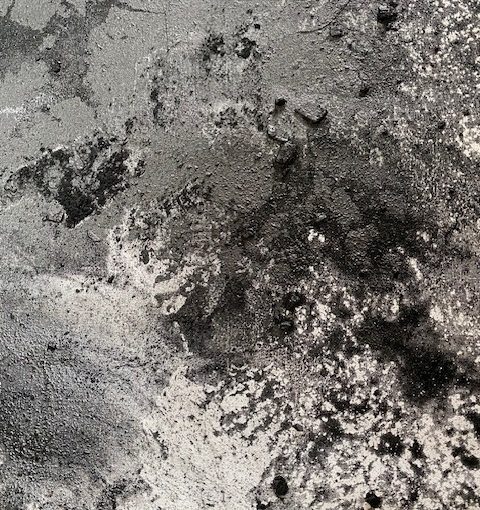In December, I investigated surfaces and mark-making for the residuals project with Oxfordshire artists Hugh Pryor and John Hazel. Canvas, paper and various grades and sizes of carbon (charcoal) were investigated. We used hands, feet, broom and sponge to research mark marking.
Mark-making with John Hazel (paper) – 22 December

John and I investigated three grades of carbon including artists charcoal powder – the finest grade rather like a flour in consistency; animal feed – a middle grade like pin oatmeal; and bio-char – the largest grade, chunky like bark chippings.

We had two investigations: one with paper – a 300 gsm paper used in plan printing – shown above; and another with a poly-cotton canvas described below.
We introduced water to the paper surface which can carried the carbon particles as if sediment in a water course like a stream; or driftwood moved by the tide onto a foreshore. Water was applied with a sponge, from a bottle by pouring and also by way of a hand diffuser spray. John noticed a sliver of blue in the otherwise black on white of the work: the surface of the water was reflecting the blue sky.
The application of the carbon was by scattering or by movement on the surface including by a socked foot, hand, fingers, sponge, and broom. Applications of carbon were made repeatedly followed by working the pigment – roughly alternating application and working although not strictly.
Of the two investigations then this one – with paper – gave the more satisfactory result.
Using water on the canvas which had previously been marked with charcoal – see 15 December below – was less satisfactory than application to the paper. The carbon was impressed into the canvas surface and had little fluidity on the canvas. Trying a wetted sponge and abrasion to move or remove the carbon on it was mostly unsuccessful. Perhaps the water was needed at the time of the original mark-making than later-on? There was another factory at work too: the previous canvas was moved and the material which lay on it’s surface was removed. A ‘freshness’ comes from the material being in place or in-situ. Considering the work as an installation rather than only a surface embodies it with differing qualities.
This investigation and the one on canvas – see below, were both at John’s home studio.
Mark-making with John Hazel (canvas) – 15 December

We used a poly-cotton canvas about 150mm wide used in plan printing. The carbon grades and application were similar to above but with water, only dry carbon.

You can see in the above image of Residuals #4, how the texture of the concrete floor is impressed through the canvas, and how the carbon/charcoal fragments sit on the surface of the canvas.

Marking with Hugh Pryor – 9 December
We investigated bio-char which is a charcoal graded for use as a soil enhancer – larger bits about a fingers width. The surface was cartridge paper in a sketchbook. Hugh picks up a piece of it with his hand and which he uses to mark the paper surface. I use my socked-foot!
We used the dance studio at the Old Fire Station Arts Centre in Oxford which we’ll be using January 2024 for the residuals project.
Thank-you
Thank you to Printer Pierre Macky (ampm technical services at The Hanger, Stanton St John) for the samples of paper and canvas used in these investigations by John Hazel and I.
